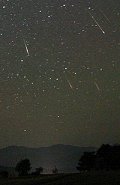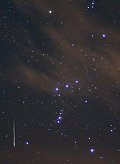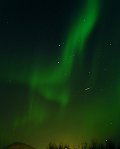|
back to spaceweather.com |
| Summary: On Oct. 21st, Earth passed through a cloud of dust from Halley's Comet, causing the annual Orionid meteor shower. Because the shower peaked while the Moon was new, sky watchers had dark skies for a mild but beautiful show: sky map. Update (10/28/06): Astronomers in Europe, Japan and North America observed an outburst of Orionids on Oct. 21st. In some places, rates exceeded 50 meteors per hour, three to five times normal. Reference: IAU Electronic Telegram 698. Unless otherwise stated, all images are copyrighted by the photographers. |
| Photographer, Location | Images | Comments | |
|
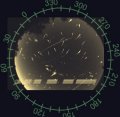
|
Chris Peterson,
Guffey, Colorado, USA Oct. 20 |
#1, more |
This is a composite image made over five nights, October 18-22. 230 Orionid meteors are captured, including many fireballs. The camera is a fisheye video system that monitors the sky all night. |
|
|
Tunc
Tezel, Kirazli village in the lower slopes (elev: 1100 meters) of Uludag (highest peak: 2543 meters); Bursa, Turkey. Oct. 21 |
#1 |
This is the 'Sky-full-of-bullets' image of the meteor shower as seen from near Kirazli village. I made this composite image using 18 pictures containing 18 Orionids, one more possible Orionid and a sporadic meteor. I took many, about 130 of these 1-minute exposures between 01:35-04:35 GMT+3 Photo details: Canon EOS D300 digital SLR at ISO 1600 and a 10-22 f/3.5-5.6 lens at 10 mm f/3.5. |
|
[listen] |
Lee
Clarke, Ashburn, Virginia Oct. 21 |
#1, #2, #3, more | Note: Meteor trails reflect and distort terrestrial radio and TV signals. Lee Clarke recorded some of these reflections during the Orionid shower. Lee Clarke: "The spectrographs are from audio recordings of the outputs of two radio receivers tuned to two different frequencies. The first image shows events occuring at different times. The second image is from the overloaded receivers whose gains were set for smaller signals, hence no audio example. The top channel is 83.25 MHz in each. The bottom channel is 55.25 MHz in each. The bandwidth for each is 3KHz. Each radio is an ICOM PCR-1000 using its own discone omni-directional scanner antenna." |
|
|
Pierre Martin,
Ottawa, Ontario Oct. 22 |
#1, #2, #3, #4 | The Orionid meteor shower provided quite a nice display this year! The peak was cloudy here, but the shower was still very active the following night when I observed and photographed several dozens of meteors. There were many bright ones. Even a night after the maximum, this was the most active Orionid shower I've ever seen. Images #2 and #3 are compositions of multiple exposures stacked together. Image #4 is not an Orionid but a brilliant slow-moving sporadic fireball. Photo details: Canon 30D with 16-35mm f/2.8 lens, Canon Digital Rebel with 35mm f/2.0 lens, 800 ASA, 20s exposures. |
|
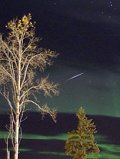
|
Yuichi Takasaka,
New Aiyansh, British Columbia, Canada Oct. 21 |
#1, more |
Orionid Auroras: "Thick clouds lifted for a brief moment to reveal Northern Lights. I took some pictures and found one with a meteor on it by surprise." |
|
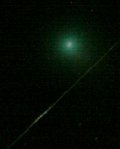
|
Brian Jolley,
Duchesne, Utah. Oct. 21 |
#1, more |
Please forgive the grainyness, poor tracking and a lens flare, but I caught a meteor cutting right through the tail of the Comet SWAN in one of the 30s exposures I was doing. Photo details: 127mm Mak-Cass, prime focus and a Canon 20D at 3200 ISO. |
|
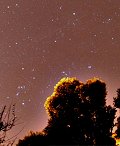
|
Mila Zinkova,
San Francisco, California, USA Oct. 21 |
#1, #2, more |
I saw a few bright Orion meteors. Of course at that time I was not taking pictures. Other were not so bright, but I looked from my light polluted back yard. Then I started to take pictures, but my battery pack run out very fast. Why is it always like that? Oh well, still it was really pretty. I'm not sorry at all I got up so early. Camera settings: 8 mm fisheye lens F5.6 Exposure was set to Bulb. I was ending shots, when I saw a meteor. |
|
|
Andreas D. Skjervold,
Bodo, Norway Oct. 21 |
#1, more |
Orionid Auroras: In just one out of 70 frames shot during one hour after midnight, I was lucky enough to get a Orionid meteor on my chip. During the hour I spent outside in a freezing wind I observed a total of 8 meteors all originated from a point slightly left of Orion. Photo details: Nikon D70, 18mm, ISO650, f/4, 30s. |
|

|
Filip Polewaczyk,
Polish Fireball Network PFN 17 Gdynia,Poland Oct. 21 |
#1, more |
Photo details: Minitron f=4mm F/1.2, field of view 51x66 degrees |
| more images: from Rob Greaves of Warboys, Cambs. UK; from Tony Wilder of Chippewa Falls, WI; |


